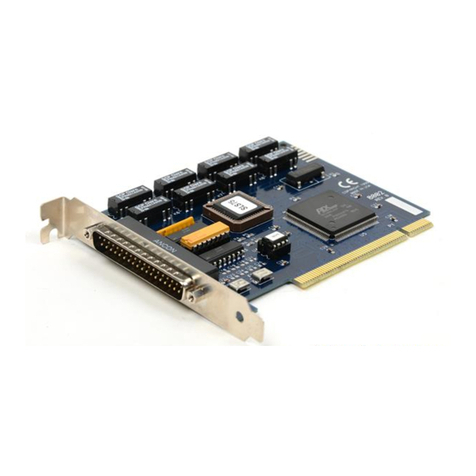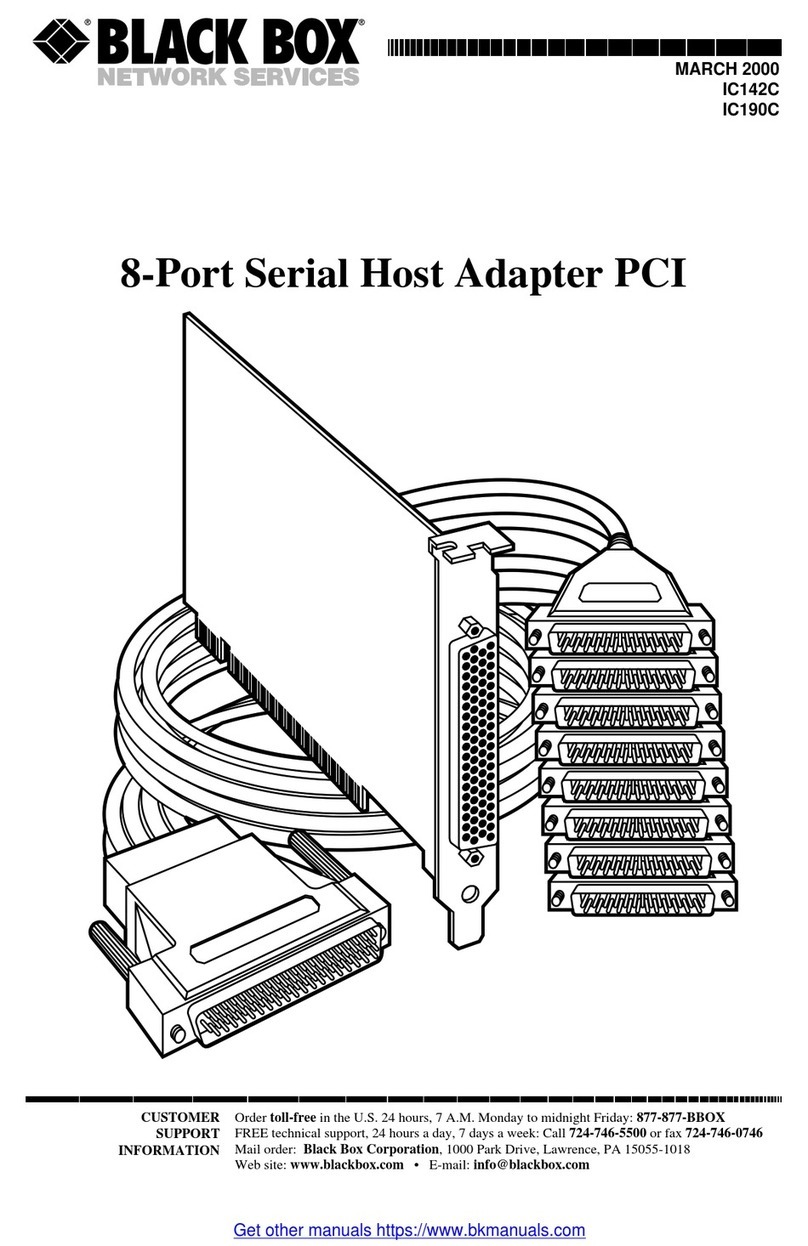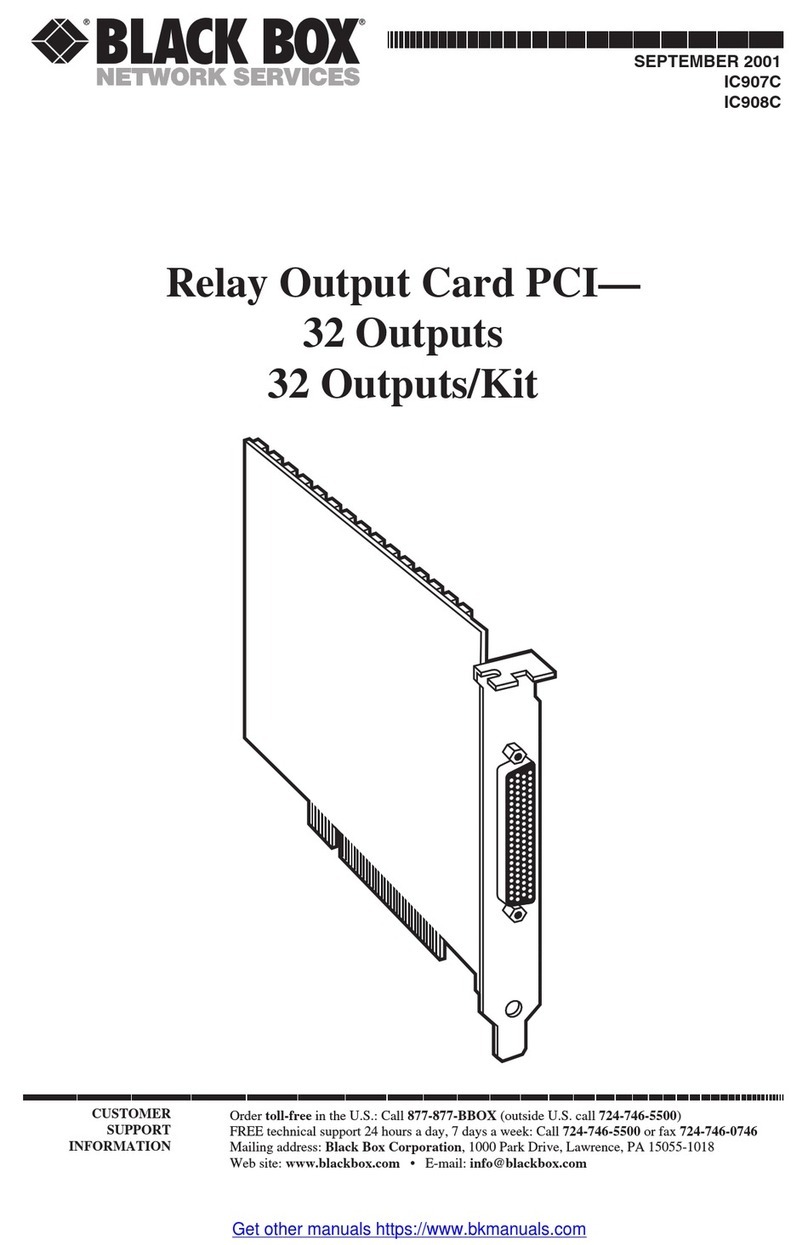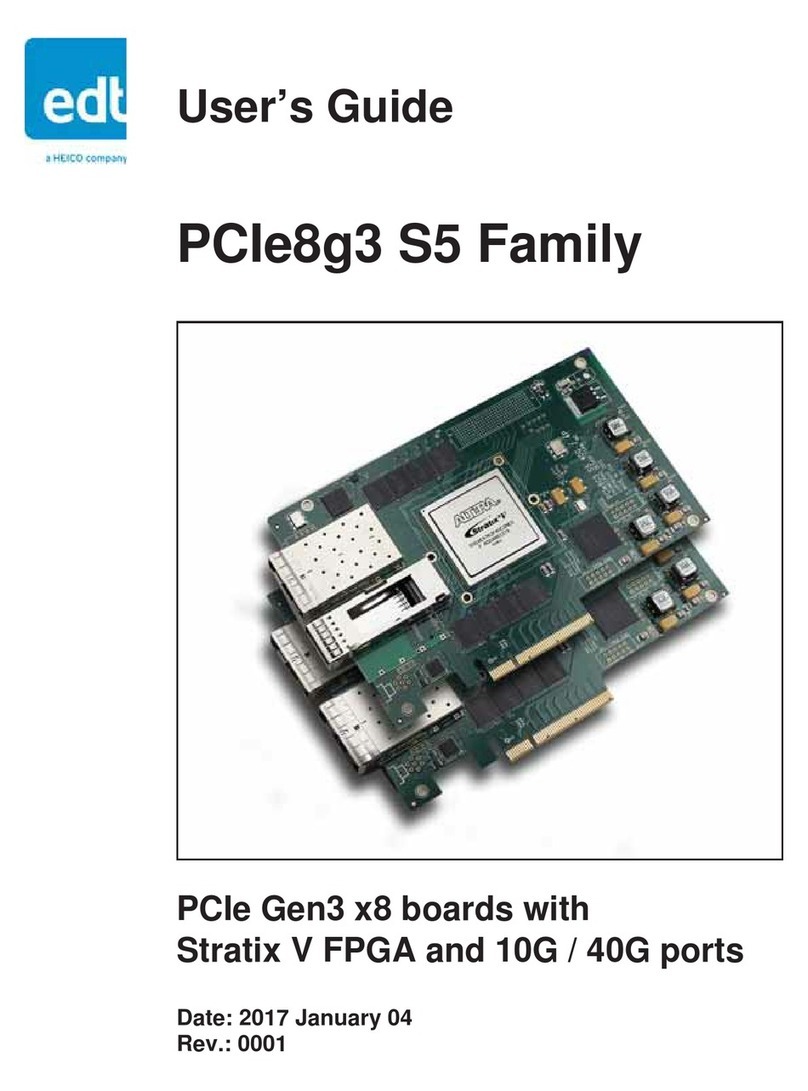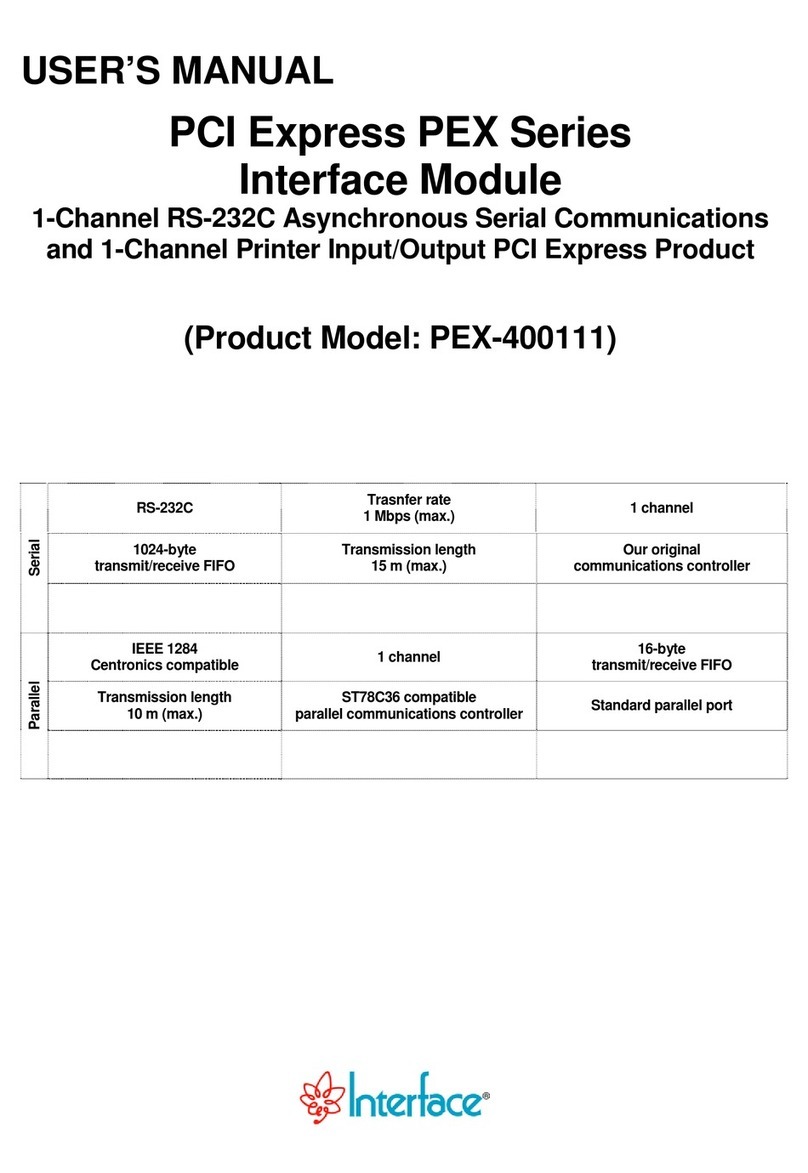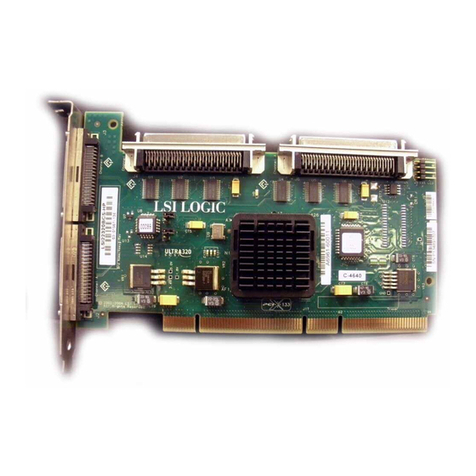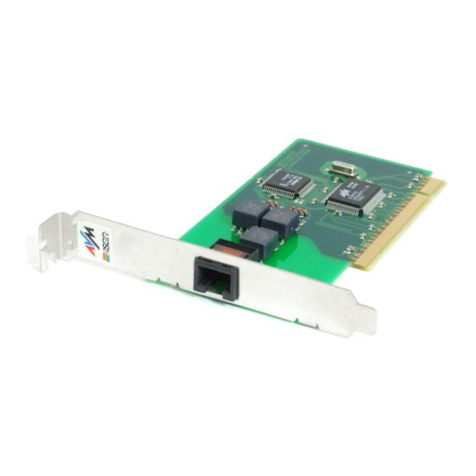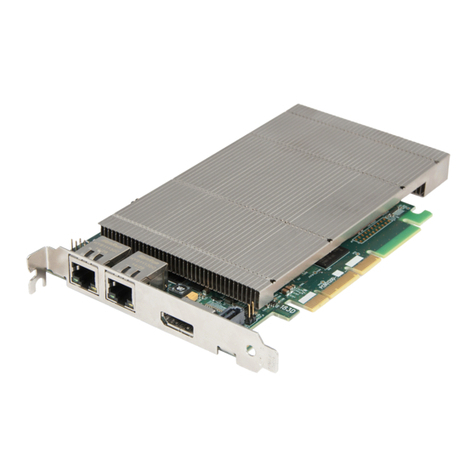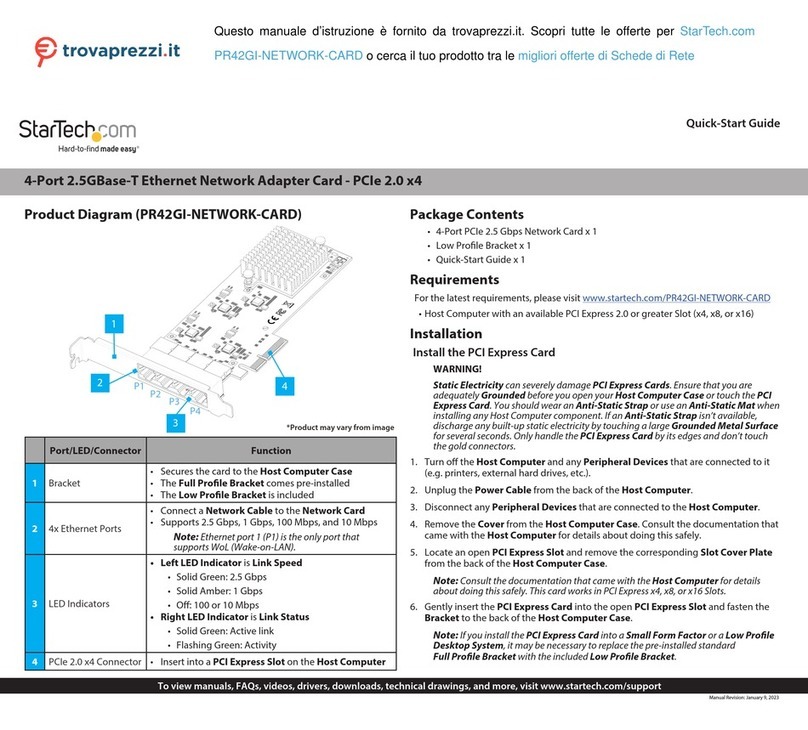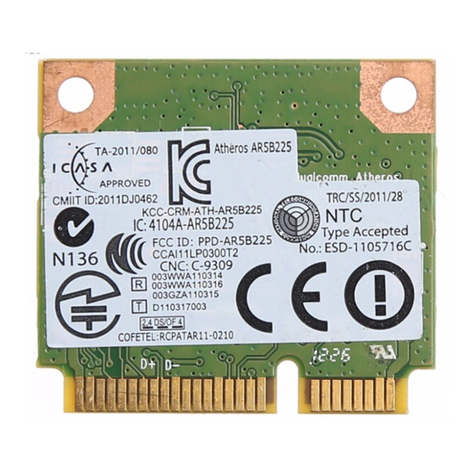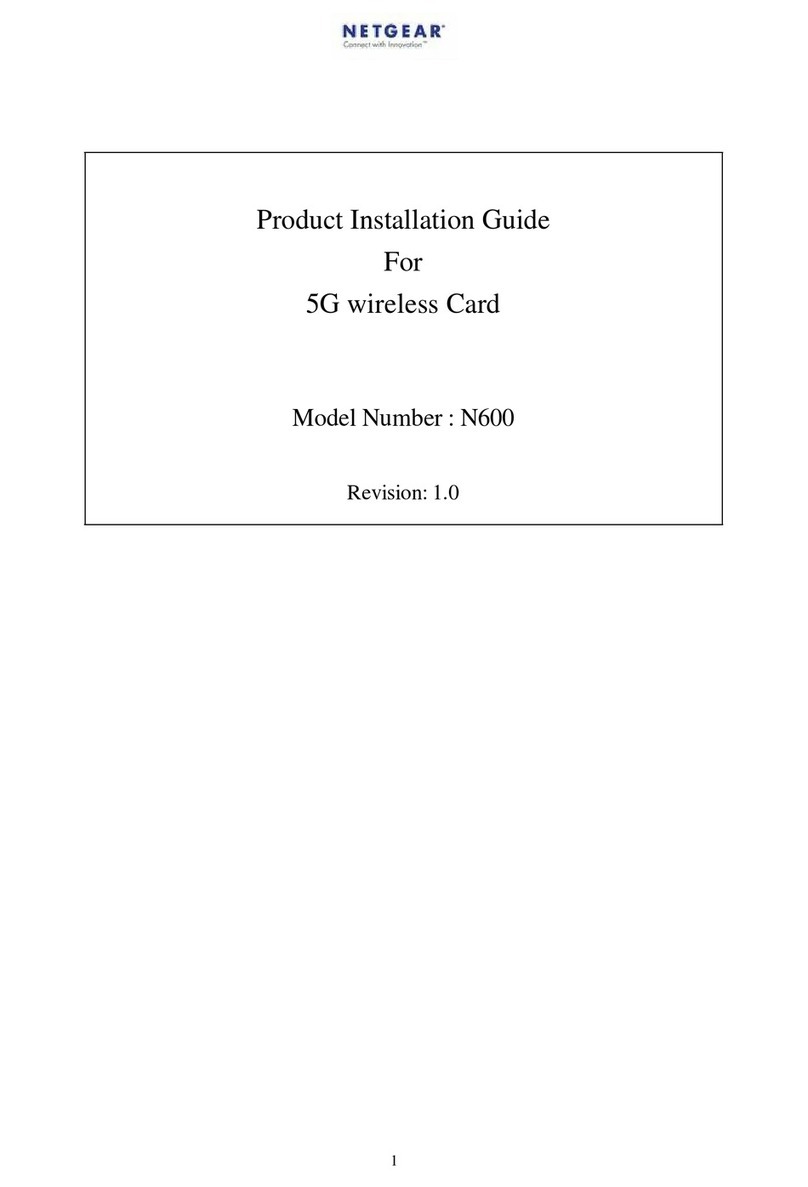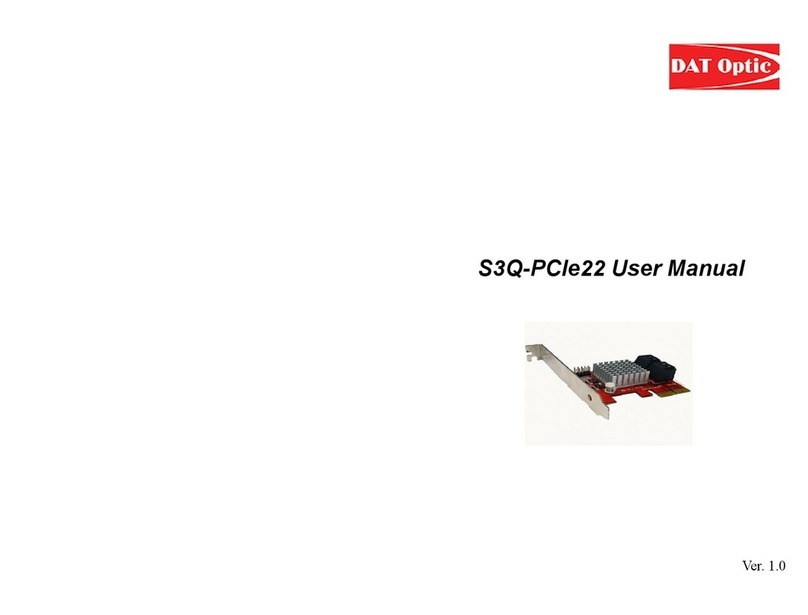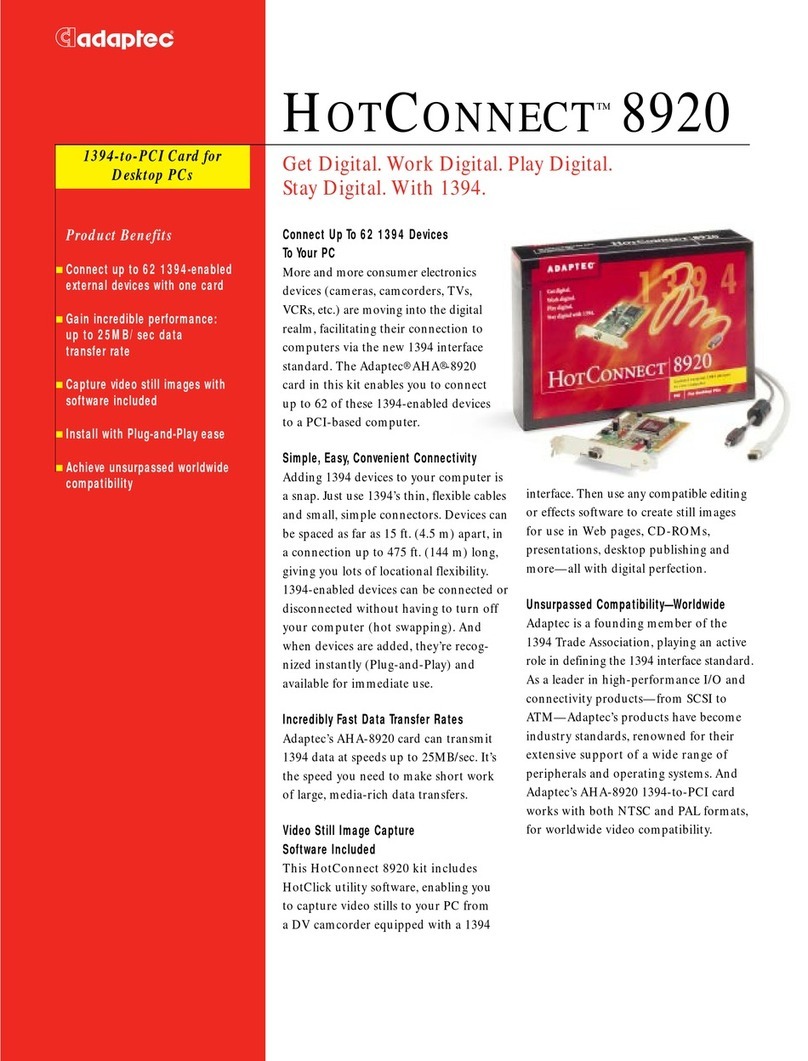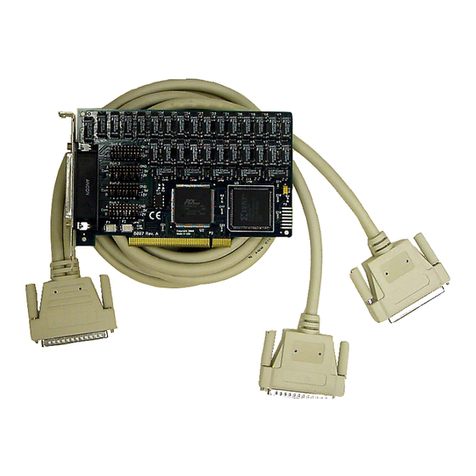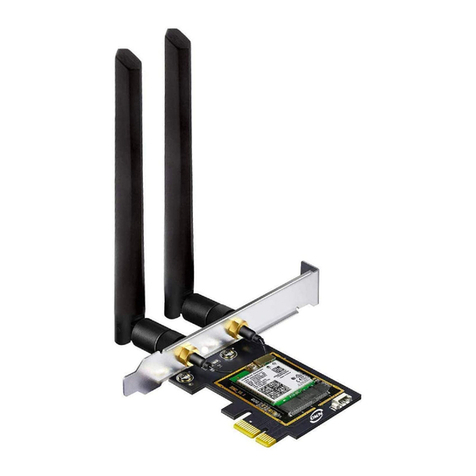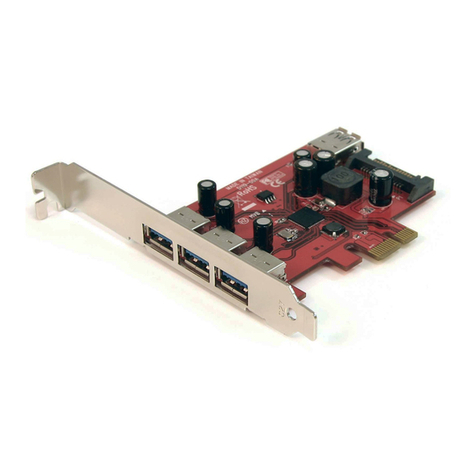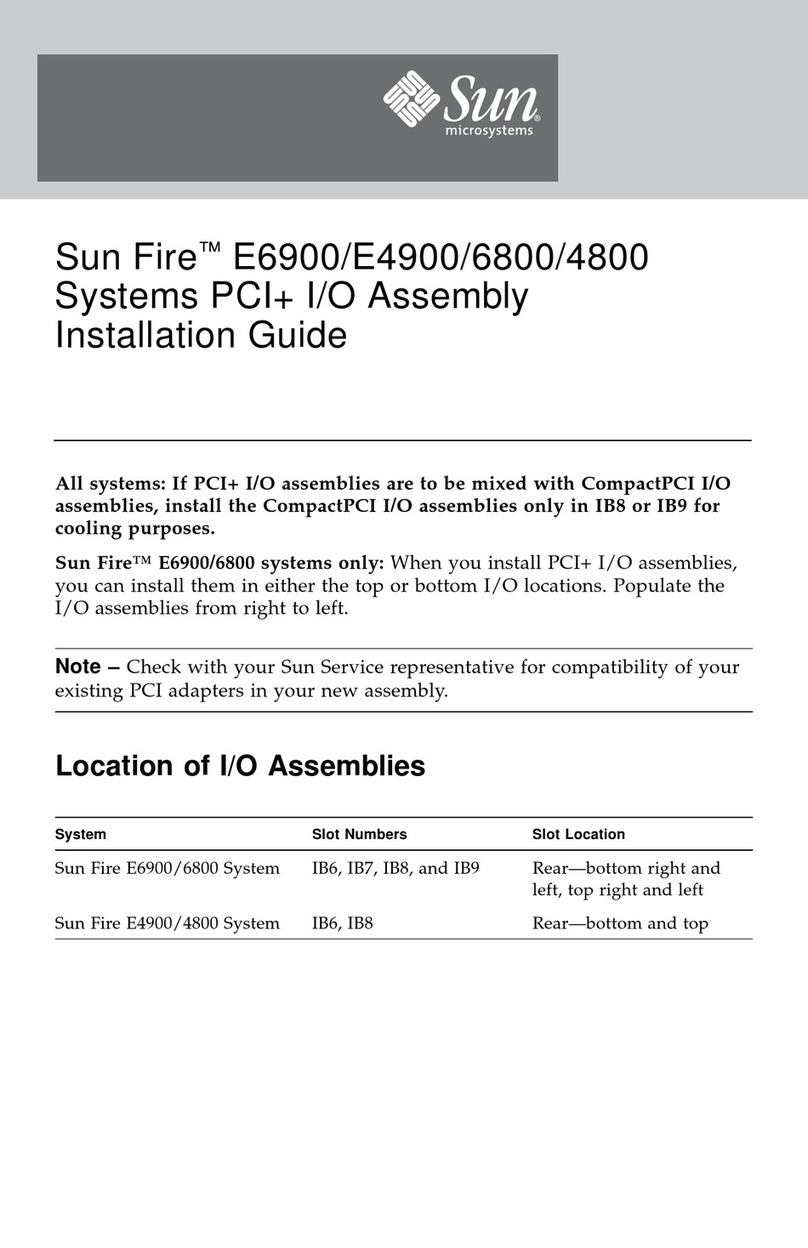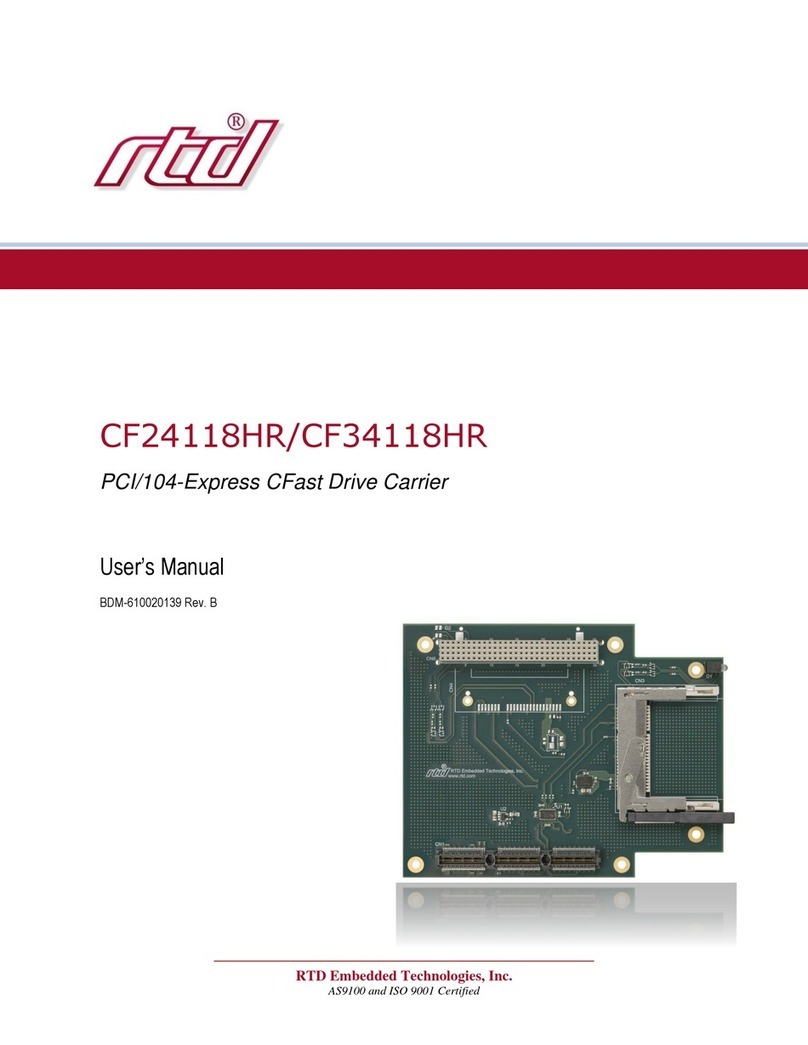Black Box USB Director RS-232 User manual

MARCH 2004
IC972C-R2
RS-232/422/485 Single-Port
PCI Card, Opto-Isolated
CUSTOMER SUPPORT INFORMATION
Order toll-free in the U.S.: Call 877-877-BBOX (outside U.S. call 724-746-5500)
FREE technical support 24 hours a day, 7 days a week: Call 724-746-5500 or fax 724-746-0746
Mailing address: Black Box Corporation, 1000 Park Drive, Lawrence, PA 15055-1018

1
FCC AND IC RFI STATEMENTS
FEDERAL COMMUNICATIONS COMMISSION
and INDUSTRY CANADA
RADIO FREQUENCY INTERFERENCE STATEMENTS
Class B Digital Device. This equipment has been tested
and found to comply with the limits for a Class B
computing device pursuant to Part 15 of the FCC Rules.
These limits are designed to provide reasonable
protection against harmful interference in a residential
installation. However, there is no guarantee that
interference will not occur in a particular installation.
This equipment generates, uses, and can radiate radio
frequency energy, and, if not installed and used in
accordance with the instructions, may cause harmful
interference to radio communications. If this
equipment does cause harmful interference to radio or
telephone reception, which can be determined by
turning the equipment off and on, the user is
encouraged to try to correct the interference by one of
the following measures:
• Reorient or relocate the receiving antenna.
• Increase the separation between the equipment
and receiver.

2
RS-232/422/485 SINGLE-PORT PCI CARD, OPTO-ISOLATED
• Connect the equipment into an outlet on a circuit
different from that to which the receiver is
connected.
• Consult an experienced radio/TV technician for
help.
CAUTION
Changes or modifications not expressly approved by the
party responsible for compliance could void the user’s
authority to operate the equipment.
To meet FCC requirements, shielded cables and power
cords are required to connect this device to a personal
computer or other Class B certified device.
This digital apparatus does not exceed the Class B limits for
radio noise emission from digital apparatus set out in the Radio
Interference Regulation of Industry Canada.
Le présent appareil numérique n’émet pas de bruits
radioélectriques dépassant les limites applicables aux appareils
numériques de classe B prescrites dans le Règlement sur le
brouillage radioélectrique publié par Industrie Canada.

3
EU DECLARATION OF CONFORMITY
EUROPEAN UNION DECLARATION OF CONFORMITY
This equipment complies with the requirements of the
European EMC Directive 89/336/EEC.

4
RS-232/422/485 SINGLE-PORT PCI CARD, OPTO-ISOLATED
NORMAS OFICIALES MEXICANAS (NOM)
ELECTRICAL SAFETY STATEMENT
INSTRUCCIONES DE SEGURIDAD
1. Todas las instrucciones de seguridad y operación deberán ser leídas antes
de que el aparato eléctrico sea operado.
2. Las instrucciones de seguridad y operación deberán ser guardadas para
referencia futura.
3. Todas las advertencias en el aparato eléctrico y en sus instrucciones de
operación deben ser respetadas.
4. Todas las instrucciones de operación y uso deben ser seguidas.
5. El aparato eléctrico no deberá ser usado cerca del agua—por ejemplo,
cerca de la tina de baño, lavabo, sótano mojado o cerca de una alberca,
etc..
6. El aparato eléctrico debe ser usado únicamente con carritos o pedestales
que sean recomendados por el fabricante.
7. El aparato eléctrico debe ser montado a la pared o al techo sólo como sea
recomendado por el fabricante.
8. Servicio—El usuario no debe intentar dar servicio al equipo eléctrico más
allá a lo descrito en las instrucciones de operación. Todo otro servicio
deberá ser referido a personal de servicio calificado.
9. El aparato eléctrico debe ser situado de tal manera que su posición no
interfiera su uso. La colocación del aparato eléctrico sobre una cama,
sofá, alfombra o superficie similar puede bloquea la ventilación, no se
debe colocar en libreros o gabinetes que impidan el flujo de aire por los
orificios de ventilación.

5
NOM STATEMENT
10. El equipo eléctrico deber ser situado fuera del alcance de fuentes de calor
como radiadores, registros de calor, estufas u otros aparatos (incluyendo
amplificadores) que producen calor.
11. El aparato eléctrico deberá ser connectado a una fuente de poder sólo del
tipo descrito en el instructivo de operación, o como se indique en el
aparato.
12. Precaución debe ser tomada de tal manera que la tierra fisica y la
polarización del equipo no sea eliminada.
13. Los cables de la fuente de poder deben ser guiados de tal manera que no
sean pisados ni pellizcados por objetos colocados sobre o contra ellos,
poniendo particular atención a los contactos y receptáculos donde salen
del aparato.
14. El equipo eléctrico debe ser limpiado únicamente de acuerdo a las
recomendaciones del fabricante.
15. En caso de existir, una antena externa deberá ser localizada lejos de las
lineas de energia.
16. El cable de corriente deberá ser desconectado del cuando el equipo no
sea usado por un largo periodo de tiempo.
17. Cuidado debe ser tomado de tal manera que objectos liquidos no sean
derramados sobre la cubierta u orificios de ventilación.
18. Servicio por personal calificado deberá ser provisto cuando:
A: El cable de poder o el contacto ha sido dañado; u
B: Objectos han caído o líquido ha sido derramado dentro del
aparato; o
C: El aparato ha sido expuesto a la lluvia; o
D: El aparato parece no operar normalmente o muestra un cambio en
su desempeño; o
E: El aparato ha sido tirado o su cubierta ha sido dañada.

6
RS-232/422/485 SINGLE-PORT PCI CARD, OPTO-ISOLATED
TRADEMARKS USED IN THIS MANUAL
IBM and PS/2 are registered trademarks of
International Business Machines Corporation.
Windows and Windows NT are either registered
trademarks or trademarks of Microsoft Corporation in
the United States and other countries.
Any other trademarks mentioned in this manual are
acknowledged to be the property of the trademark owners.

7
CONTENTS
Contents
Chapter Page
1. Specifications . . . . . . . . . . . . . . . . . . . . . . . . . . . . 9
2. Introduction . . . . . . . . . . . . . . . . . . . . . . . . . . . 10
2.1 Overview . . . . . . . . . . . . . . . . . . . . . . . . . . . 10
2.2 What the Package Includes . . . . . . . . . . . . 11
2.3 Factory-Default Settings. . . . . . . . . . . . . . . 12
2.4 Technical Description . . . . . . . . . . . . . . . . 12
2.5 Connector Pin Assignments . . . . . . . . . . . 13
3. Card Setup . . . . . . . . . . . . . . . . . . . . . . . . . . . . . 14
3.1 Electrical Interface Selection . . . . . . . . . . 14
3.2 Line Termination. . . . . . . . . . . . . . . . . . . . 16
3.3 RS-485 Enable Modes . . . . . . . . . . . . . . . . 17
3.4 Clock Modes. . . . . . . . . . . . . . . . . . . . . . . . 19
3.5 Baud Rates and Divisors for
D1 Mode . . . . . . . . . . . . . . . . . . . . . . . . . 19
4. Installation . . . . . . . . . . . . . . . . . . . . . . . . . . . . . 21
4.1 Operating System Installation. . . . . . . . . . 21
4.1.1 For Windows Users . . . . . . . . . . . . . 21
4.1.2 Other Operating Systems. . . . . . . . 21
4.2 System Installation . . . . . . . . . . . . . . . . . . . 21

8
RS-232/422/485 SINGLE-PORT PCI CARD, OPTO-ISOLATED
Contents (continued)
Chapter Page
Appendix A. Troubleshooting. . . . . . . . . . . . . . . . . 23
A.1 Tips . . . . . . . . . . . . . . . . . . . . . . . . . . . . . . . 23
A.2 Calling Black Box. . . . . . . . . . . . . . . . . . . . 24
A.3 Shipping and Packaging . . . . . . . . . . . . . . 25
Appendix B. Electrical Interfaces . . . . . . . . . . . . . . 26
B.1 RS-232 . . . . . . . . . . . . . . . . . . . . . . . . . . . . . 26
B.2 RS-422 . . . . . . . . . . . . . . . . . . . . . . . . . . . . . 27
B.3 RS-485 . . . . . . . . . . . . . . . . . . . . . . . . . . . . . 28
Appendix C. Ground Loop Phenomenon . . . . . . . 30
C.1 What is Ground Loop? . . . . . . . . . . . . . . . 30
C.2 Cabling Recommendations. . . . . . . . . . . . 30
Appendix D. Asynchronous Communication . . . . 32
Appendix E. Board Layout. . . . . . . . . . . . . . . . . . . . 35

9
CHAPTER 1: Specifications
1. Specifications
UART: 16850
Speed: RS-422/485: Up to 460.8 kbps
Maximum Distance: RS-422: Up to 4000 ft. (1219.2 m)
MTBF: Greater than 150,000 hours (calculated)
Interface: RS-232/422/485, Opto-Isolated
Connectors: (1) DB25 male
Indicators: None
Temperature Tolerance: Operating: 32 to 122°F (0 to
50°C); Storage: -4 to +158°F (-20 to +70°C)
Relative Humidity: 10 to 90%, noncondensing
Power: +5 VDC or +3.3 VDC PCI expansion, 480 mA
Size: 2.2"H x 4.7"W (5.6 x 11.9 cm), excluding
goldfingers; 2.5"H x 4.7"W (6.4 x 11.9 cm), including
goldfingers
Weight: 3.3 oz. (93.6 g)

10
RS-232/422/485 SINGLE-PORT PCI CARD, OPTO-ISOLATED
2. Introduction
2.1 Overview
The RS-232/422/485 Single-Port PCI Card, Opto-
Isolated is a single-channel isolated PCI Bus serial I/O
adapter for PCs and compatibles. Using a 16850 UART
with its industry-leading 128-byte FIFOs, it provides a
field-selectable RS-232/422/485 serial port that supports
data rates up to 460.8 kbps (RS-422/485).
Configure the PCI card as RS-232 for standard serial
COM: port requirements. Choose the RS-422 mode for
long-distance device connections up to 4000 ft.
(1219.2 m), where noise immunity and high data
integrity are essential. Select RS-485 and capture data
from multiple peripherals in an RS-485 multidrop
network. Up to 31 RS-485 devices can be connected to
each port to automate your data collection. You can
even mix the ports in any of the interface combinations
to provide maximum flexibility to your application.
Optional DB25 to terminal block adapters (part number
IC980) are available to simplify field-wiring connections.

11
CHAPTER 2: Introduction
In both RS-232 and RS-422 modes, the card works
seamlessly with the standard operating system serial
driver. In RS-485 mode, our special auto-enable feature
allows the RS-485 ports to be viewed by the operating
system as a COM: port. This means that the standard
COM: driver can be used for RS-485 communications.
Our on-board hardware automatically handles the
RS-485 driver enable.
2.2 What the Package Includes
The PCI card is shipped with the following items.
• (1) RS-232/422/485 Single-Port PCI Card.
• (1) Serial Utilities CD-ROM containing drivers for
Windows®3.1x/95/98/2000 and Windows NT®,
Advanced COM drivers, utilities, INF files, help
files, and this users’ manual in PDF format.
If either item is missing or damaged, contact Black Box
at 724-746-5500.

12
RS-232/422/485 SINGLE-PORT PCI CARD, OPTO-ISOLATED
2.3 Factory-Default Settings
When shipped from the factory, the PCI card’s DB25
port is configured as RS-422.
To install the PCI card using factory-default settings,
refer to Chapter 4.
2.4 Technical Description
The RS-232/422/485 Single-Port PCI Card, Opto-
Isolated provides a PCI interface adapter with an
isolated asynchronous serial port that gives you a
versatile interface, field-selectable as RS-232 for
modems, printers and plotters, as well as RS-422/485 for
industrial automation and control applications. Isolation
is important in installations where the equipment being
connected to the PC is either far from the PC or on a
different power transformer circuit. Ground loop
current is a commonly neglected and misunderstood
phenomenon that leads to data loss and the destruction
of communications interfaces.
The PCI card uses the 16850 UART. This chip features
programmable baud rates, data format, interrupt
control, and industry-leading 128-byte FIFOs.

13
CHAPTER 2: Introduction
2.5 Connector Pin Assignments
Table 2-1. RS-232 signals (DB25 male).
Signal Name Pin # Mode
GND Ground 7 —
RD Receive Data 3 Input
CTS Clear To Send 5 Input
TD Transmit Data 2 Output
RTS Request To Send 4 Output
NOTE
These assignments meet EIA/TIA/ANSI-232E DTE
standards.
TECHNICAL NOTE
Please terminate any control signals that are not going to
be used. The most common way to do this is to connect
RTS to CTS and RI. Also, connect DCD to DTR and DSR.
Terminating these pins, if not used, will help ensure that
you get the best performance from your adapter.
Table 2-2. RS-422/485/530 pin assignments (DB25 male).
Signal Name Pin # Mode
GND Ground 7 —
RDB RX+ Receive Data Positive 16 Input
RDA RX- Receive Data Negative 3 Input
CTSB CTS+ Clear To Send Positive 13 Input
CTSA CTS- Clear To Send Negative 5 Input
TDB TX+ Transmit Data Positive 14 Output
TDA TX- Transmit Data Negative 2 Output
RTSB RTS+ Request To Send Positive 19 Output
RTSA RTS- Request To Send Negative 4 Output

14
RS-232/422/485 SINGLE-PORT PCI CARD, OPTO-ISOLATED
3. Card Setup
3.1 Electrical Interface Selection
The RS-232/422/485 Single-Port PCI Card can be used
as RS-232, RS-422, or RS-485. This is selectable via
DIP-switch SW1. Please use the following examples to
configure your PCI card.
Figure 3-1. RS-232.
Figure 3-2. RS-422.
1 2 3 T P P L L E
1 2 3 T P P L L E

15
CHAPTER 3: Card Setup
Figure 3-3. RS-485 4-wire with echo.
Figure 3-4. RS-485 2-wire with echo.
Figure 3-5. RS-485 2-wire without echo.
1 2 3 T P P L L E
1 2 3 T P P L L E
1 2 3 T P P L L E

16
RS-232/422/485 SINGLE-PORT PCI CARD, OPTO-ISOLATED
3.2 Line Termination
Typically, each end of the RS-485 bus must have
line-terminating resistors (RS-422 terminates at the
receive end only). A 120-ohm resistor is across each
RS-422/485 input in addition to a 1K ohm pull-up/
pull-down combination that biases the receiver inputs.
Switches SW1 and SW2 allow the user to customize this
interface to his/her specific requirements. Each switch
position corresponds to a specific portion of the
interface. If multiple PCI cards are configured in an
RS-485 network, only the boards on each end should
have jumpers T, P, and P on. Refer to Table 3-1 for each
position’s operation.
Table 3-1. Jumper settings.
Name Function
T Adds or removes the 120-ohm termination.
P Adds or removes the 1K ohm pull-down resistor in the
RS-422/RS-485 receiver circuit (Receive data only).
P Adds or removes the 1K ohm pull-up resistor in the
RS-422/RS-485 receiver circuit (Receive data only).
L Connects the TX+ to RX+ for RS-485 two-wire operation.
L Connects the TX- to RX- for RS-485 two-wire operation.

17
CHAPTER 3: Card Setup
3.3 RS-485 Enable Modes
RS-485 is ideal for multi-drop or network environments.
RS-485 requires a tri-state driver that will allow the
electrical presence of the driver to be removed from the
line. The driver is in a tri-state or high impedance
condition when this occurs. Only one driver may be
active at a time and the other driver(s) must be tri-
stated. The output modem control signal Request To
Send (RTS) is typically used to control the state of the
driver. Some communication software packages refer to
RS-485 as RTS Enable or RTS block mode transfer.
One of the unique features of the PCI card is the ability
to be RS-485 compatible without the need for special
software or drivers. This ability is especially useful in
operating systems where the lower-level I/O control is
abstracted from the application program. You can
effectively use the PCI card in an RS-485 application
with existing (that is, standard RS-232) software drivers.
Switch SW2 is used to control the RS-485 mode
functions for the driver circuit (see Figure 3-6). The
selections are RTS Enable (silk-screen “RT,” switch
position 4) or Auto Enable (silk-screen “AT,” switch
position 3). The Auto Enable feature automatically

18
RS-232/422/485 SINGLE-PORT PCI CARD, OPTO-ISOLATED
enables/disables the RS-485 interface. The RTS mode
uses the RTS modem control signal to enable the RS-485
interface and provides backward compatibility with
existing software products.
Figure 3-6. RS-485 enable modes.
The RS-485 Echo is the result of connecting the receiver
inputs to the transmitter outputs. Every time a character
is transmitted, it is also received. This can be beneficial if
the software can handle echoing (that is, using received
characters to throttle the transmitter) or it can confuse
the system if the software does not. Position 9 of SW1 is
used to control the RS-485 enable/disable functions for
the receiver circuit. To select the No Echo mode, place
switch position 9 to the On position (see Figure 3-5).
DDAR
1 4 T T
SW2 RS-232/
422 Default SW2 RS-485
Auto Enabled
DDAR
1 4 T T

19
CHAPTER 3: Card Setup
3.4 Clock Modes
The PCI card uses a unique clocking option that lets you
select from “divide by 4” and “divide by 1” clocking
modes. These modes are selected at switches SW-2.
To select the baud rates commonly associated with
COM: ports (that is, 2400, 4800, 9600, 19.2, …
115.2 kbps), set switch-position 2 to the On position
(silk-screen D4). To select the maximum data rate
(460.8 kbps), set switch-position 1 to the On position
(silk-screen D1).
Figure 3-7. Clocking modes.
3.5 Baud Rates and Divisors for D1 Mode
Table 3-2 (on the next page) shows some common data
rates and the rates you should choose to match them if
using the PCI card in D1 mode.
DDAR
1 4 T T
Divide by 4 mode Divide by 1 mode
DDAR
1 4 T T
Other manuals for USB Director RS-232
11
This manual suits for next models
3
Table of contents
Other Black Box PCI Card manuals

Black Box
Black Box IC126C User manual
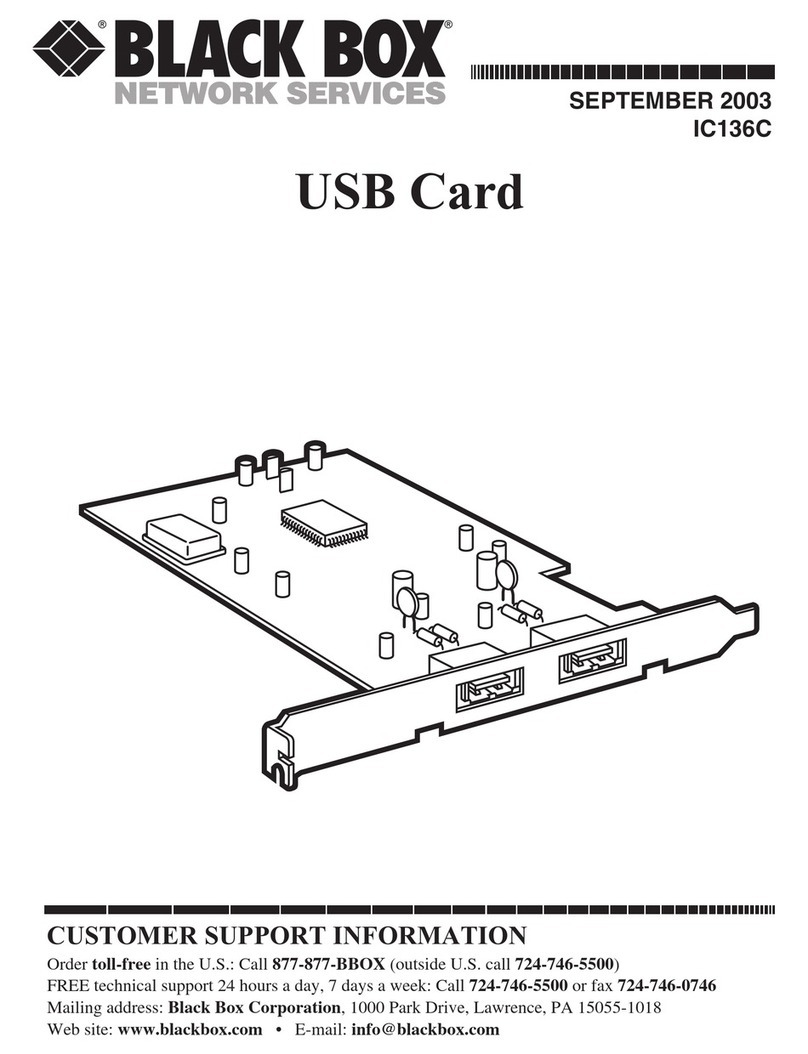
Black Box
Black Box IC136C User manual
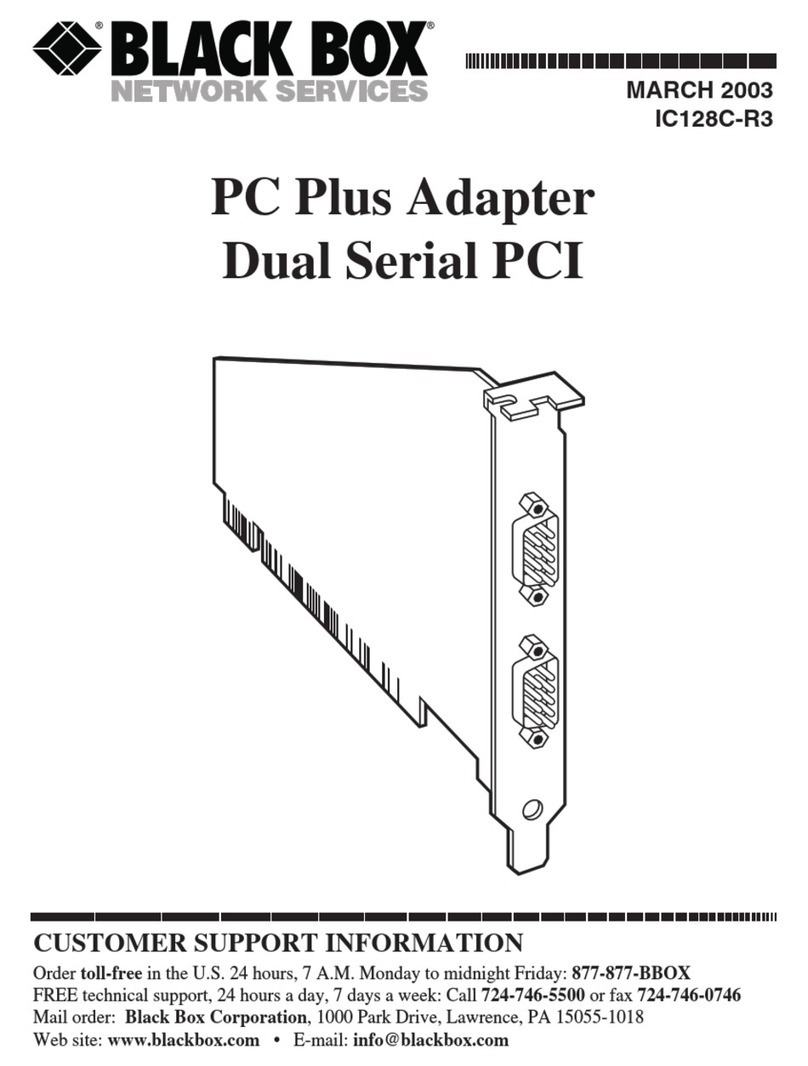
Black Box
Black Box IC128C-R3 User manual

Black Box
Black Box IC906C User manual
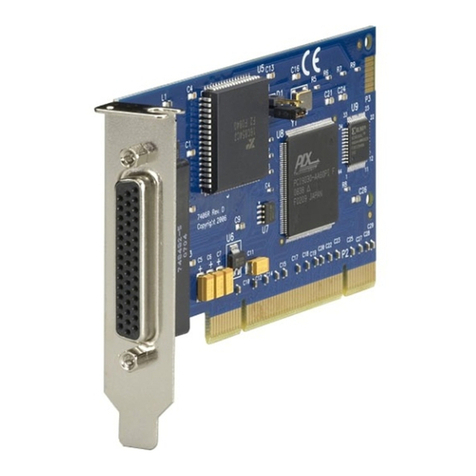
Black Box
Black Box IC132C User manual

Black Box
Black Box LH1390C-SC-R2 User manual
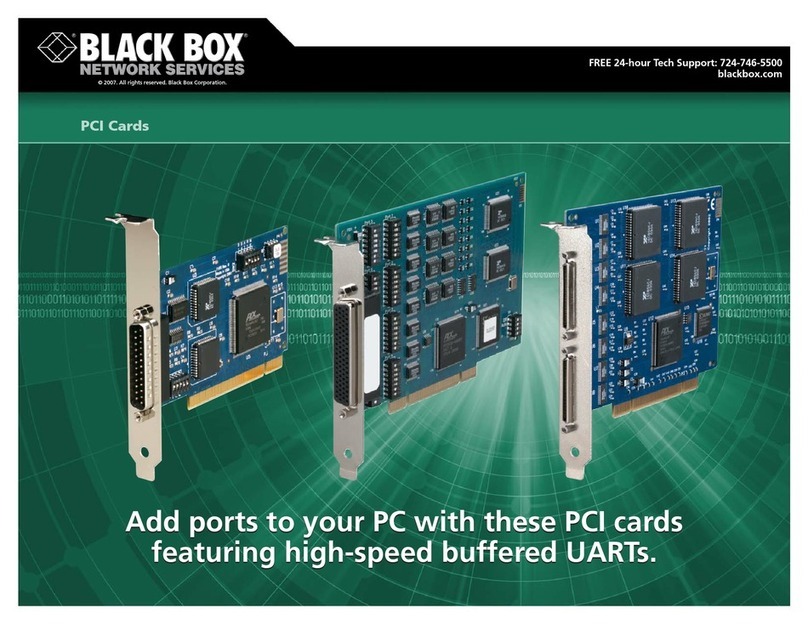
Black Box
Black Box IC142C User manual
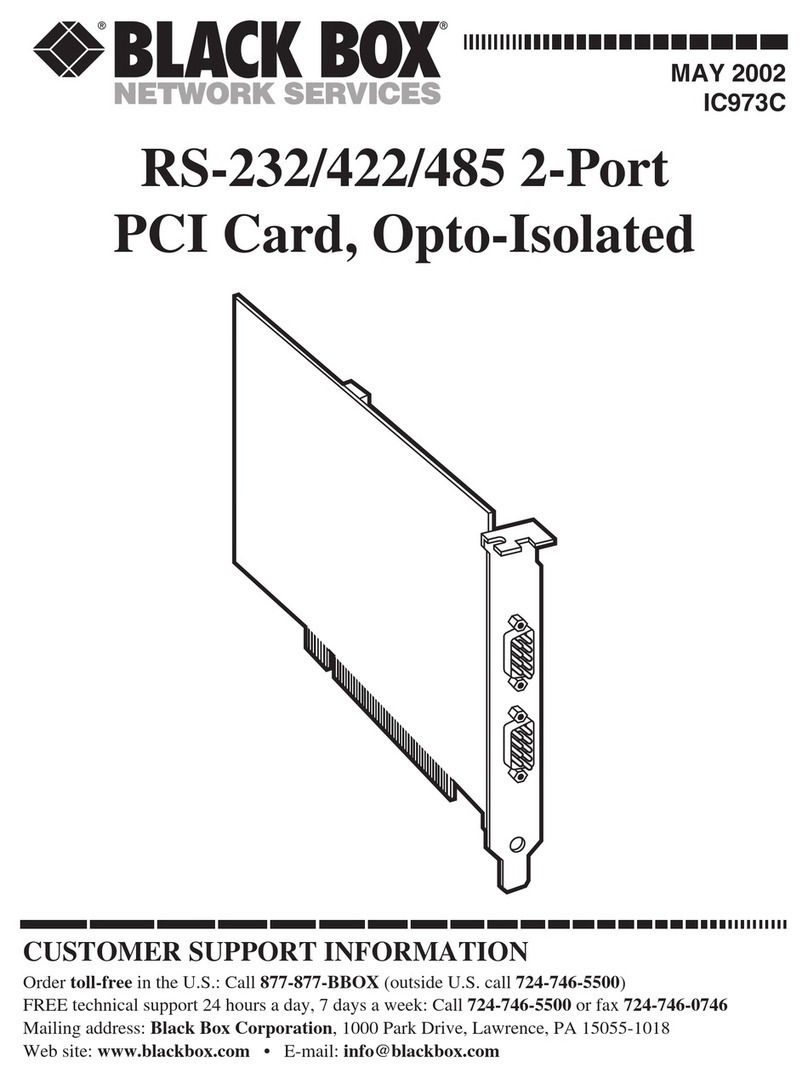
Black Box
Black Box USB Director RS-232 User manual

Black Box
Black Box IC142C User manual

Black Box
Black Box RS-422 User manual
